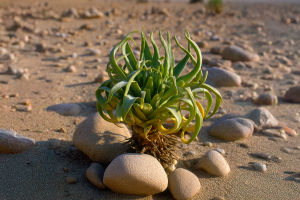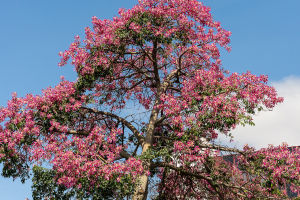Imagine a flower so enormous and rare that people line up for hours just to see it, even though it smells terrible. That is the Titan arum, also called the corpse flower.
Native to the tropical rainforests of Sumatra, this plant is famous for producing the world's largest unbranched inflorescence, sometimes reaching over 3 meters (10 feet) tall.
When it blooms, it releases a powerful odor similar to rotting flesh—an unforgettable experience for anyone who gets close.
Why It Smells the Way It Does
We might ask why would a flower smell so awful? The Titan arum has a clever survival strategy. Unlike roses that attract bees, it lures beetles and flies that normally feed on decaying meat. The strong odor guides these insects to the flower, where they help with pollination. To us, the smell may be shocking, but for the flower, it's nature's way of ensuring the next generation.
A Giant in the Plant World
The Titan arum's size is astonishing. Its central spike, called a spadix, grows taller than most people. This spadix is surrounded by a large, frilly, leaf-like sheath called a spathe, which looks like a huge petal and can spread several feet wide. Inside the base of the spadix, small male and female flowers grow together. The female flowers open first, followed by the males a day later, preventing self-pollination and improving the chances of cross-pollination.
A Rare and Short-Lived Event
Here's the amazing part: the Titan arum doesn't bloom often. A single plant may take 7 to 10 years to store enough energy before flowering for the first time. After that, it might bloom again only every few years. Even then, the bloom lasts just two to three days before the spathe closes. That's why each flowering event becomes such a big deal, drawing huge crowds to botanical gardens around the world.
Its Other Life as a "Tree"
When it's not flowering, the Titan arum grows a single gigantic leaf that looks like a small tree. This leaf can grow 6 meters (20 feet) tall and 5 meters (16 feet) wide, helping the underground tuber store enough energy for the next bloom. After the leaf dies back, the tuber rests for several months before starting the cycle again. This unusual growth pattern makes the plant even more mysterious.
Endangered in the Wild
Sadly, Titan arum is listed as endangered. Its native rainforests in Sumatra face rapid deforestation, leaving the species at risk. Thankfully, many botanical gardens around the world now cultivate it to protect the species and allow more people to witness its rare bloom. Each public bloom not only excites visitors but also spreads awareness about rainforest conservation.
Where We Can See It
If we want to see a Titan arum in bloom, botanical gardens are our best bet. Some famous ones include the United States Botanic Garden in Washington, D.C., the Royal Botanic Gardens at Kew in London, and the Bogor Botanical Gardens in Indonesia. Visiting these places often requires timing and luck, since blooms are unpredictable. Many gardens announce flowering events on social media, giving us a chance to plan our visit before the bloom fades.
Visiting Tips
For Lykkers who dream of seeing a Titan arum:
- Check garden websites or announcements before going, since blooms are rare.
- Expect long lines during peak viewing days, especially on the first day of the bloom.
- Bring a camera, but also be ready for the smell—it's powerful, especially at night when the odor is strongest.
- If we can't travel, many gardens now livestream the event online, so people around the world can join in.
Final Thoughts on the Titan Arum
The Titan arum is more than just a giant plant—it's a testament to nature's creativity and surprises. From its towering size to its unforgettable scent, every detail reminds us how diverse and fascinating our world can be. We might not love the odor, but the memory of witnessing a bloom will stay with us forever.
Perhaps one day we'll get the chance to see this rare giant in full bloom. Who knows? The next incredible display could be just around the corner, waiting for us to experience it firsthand!


